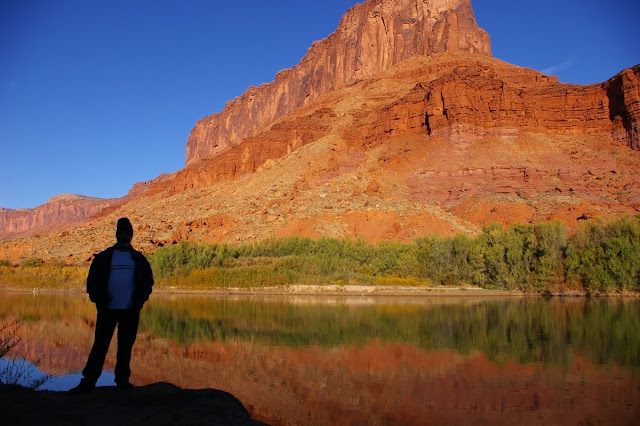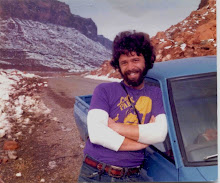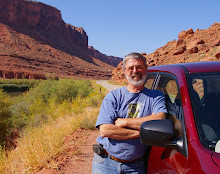 March 17 - Barstow, California is not exactly the garden spot of the west but in the pre-dawn light almost anything looks better than normal. That being said, I decided to catch the sunrise at Casa del Deseirto, the old Fred Harvey establishment that has been restored and still stands alongside the railroad tracks on the seedier side of town. The impressive Mission Revival structure with its many arches and Spanish flourishes is an architectural gem nearly lost amidst the jumbled rail yards and sere hillsides around it. I got some photographs of the first light of day reflecting off the rails and into the fine old building.
March 17 - Barstow, California is not exactly the garden spot of the west but in the pre-dawn light almost anything looks better than normal. That being said, I decided to catch the sunrise at Casa del Deseirto, the old Fred Harvey establishment that has been restored and still stands alongside the railroad tracks on the seedier side of town. The impressive Mission Revival structure with its many arches and Spanish flourishes is an architectural gem nearly lost amidst the jumbled rail yards and sere hillsides around it. I got some photographs of the first light of day reflecting off the rails and into the fine old building.After that it was back to the open road, following old Route 66 through places like Lenwood, Helendale and Oro Grande. Halfway to Lancaster I began to get the classic view of Joshua trees against the snow clad San Gabriels. I got lost several times on roads where minimal maintenance is the rule but I eventually reached Lancaster and from there continued east on Hwy.138 in search of the Antelope Hills Poppy Preserve, a chunk of California real estate set aside strictly for the preservation and enjoyment of spectacular blooming hillsides full of native wildflowers. Unfortunately, I arrived about two weeks too early for the peak blooms so had to content myself with a few patches of poppies and fiddlenecks. But at least I was finally seeing some flowers.
I was determined to reach the Carrizo Plain that afternoon so I continued west to Interstate 5 and drove over Wheeler Ridge into the broad (and smoggy) San Joaquin Valley. The pace of traffic seemed positively frenetic so it was a real relief to bail out at Hwy. 166, a straight-as-an-arrow, two-lane country road that seemed to go on endlessly. The smog and haze was so thick that I drove at least 30 miles before I began to discern the low range of mountains that held my destination. This is the aptly named Temblor Range which runs directly adjacent to and is a product of the San Andreas Fault.
The southern entrance into the Carrizo Plain is a lonely road indeed. Broad and treeless, flanked by two low mountain ranges, the aforementioned Temblor and the Caliente Mountains to the west. Here and there were abandoned farm equipment, crumbling sheds and small alkali ponds. I was beginning to doubt my initial urge to visit this place. But as the pavement ended and I continued north on a wide dirt road, the magic began to kick in. The hills became softer, swathed in green. The green soon turned to the yellow of unbroken flower fields. Masses of wooly daisies, goldfields and fiddlenecks. The smog began to dissipate and my senses could begin to grasp the immense emptiness and beauty of this place.
That afternoon I camped in a copse of eucalyptus trees in the BLM’s KCL Campground, a primitive little spot with eight campsites, tables, no water, no fees, and plenty of solitude. The campground is situated at the base of the Calientes with unobstructed views in nearly all directions. Only three other sites were taken. I spent the remainder of the day wandering the nearby fields photographing flowers and listening to the endless cacophony of bird sounds, mostly meadowlarks and redwing black birds. Later that evening I was serenaded by a great horned owl who had a nest nearby.
It is a rare event anymore to find a campground that is truly quiet, where your fellow campers seem to have a real appreciation of their surroundings. No barking dogs or blaring radios. Not even a campground host. Clearly the Carrizo is not a destination spot and hasn’t made the pages of OUTDOOR magazine yet....and probably never will. The place exists on its own terms for one to accept or reject. I was totally charmed by the place, and slept an untroubled sleep that night in the back of my car.









